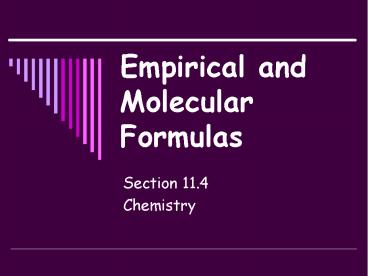Empirical and Molecular Formulas - PowerPoint PPT Presentation
Title:
Empirical and Molecular Formulas
Description:
Empirical and Molecular Formulas Section 11.4 Chemistry Objectives Explain what is meant by the percent composition of a compound. Determine the empirical and ... – PowerPoint PPT presentation
Number of Views:453
Avg rating:3.0/5.0
Title: Empirical and Molecular Formulas
1
Empirical and Molecular Formulas
- Section 11.4
- Chemistry
2
Objectives
- Explain what is meant by the percent composition
of a compound. - Determine the empirical and molecular formulas
for a compound from mass percent and actual mass
data.
3
Key Terms
- Percent composition
- Empirical formula
- Molecular formula
4
Percent Composition
- Percent by mass of each element in a compound.
- Mass of Element x 100
- Mass of Compound
5
Example
- Calculate percent composition of H in H2O
- Molar mass of water 18.02 g/mol
- Determine mass of H in 1 mol of H2O
6
Mass of H
- 1.01 x 2 2.02 g H in 1 mol water
Atomic mass of H from periodic table
Number of H in H2O
7
Percent Composition of H
- 2.02 g of H x 100 11.2 H
- 18.02 g of H2O
8
Empirical Formula
- Formula for a compound with the smallest
whole-number ratio of elements. - Percent composition can be used to find the
chemical formula.
9
Empirical Formula
- When given percent composition, assume
- The total mass of the compound is 100 g
- The percent composition of the element is equal
to the mass in grams of the element.
10
Example
- A compound has a percent composition of 40.05 S
and 59.95 O. - So in 100 g of the compound, 40.05 g are S and
59.95 g are O. - Find the amount of mol for each element.
11
Empirical Formula
- 40.05g S x 1 mol S 1.249 mol S
- 32.07g S
- 59.95g O x 1 mol O 3.747 mol O
- 16.00g O
12
Empirical Formula
- The element with the smallest number of mol gets
the subscript 1.
13
Empirical Formula
- S has a subscript 1
- Then divide the mol O by the mol S
- 3.747 mol O/ 1.249 mol S 3 mol O
- Then write your empirical formula using your
subscripts SO3
14
Practice Problems
- Pg. 333
15
Molecular Formula
- Formula that specifies the actual number of atoms
of each element in one molecule or formula unit
of a substance. - n molecular formula mass
- empirical formula mass
16
Example
- Compound is composed of 40.68 carbon, 5.08
hydrogen, and 54.24 oxygen and has a mass of
118.1 g/mol. Determine the empirical and
molecular formulas for succinic acid.
17
Example
- 40.68 g C x 1 mol C 3.387 mol C
- 12.01 g C
- 5.08 g H x 1 mol H 5.04 mol H
- 1.008 g H
- 54.24 g O x 1 mol O 3.390 mol O
- 16.00 g O
18
Example
- 3.387 mol C/ 3.387 1 mol C
- 5.040 mol H/ 3.387 1.49 1.5 mol H
- 3.390 mol O/ 3.387 1.001 1 mol O
- Ratio of C H O 1 1.5 1
19
Example
- Empirical Formula C2H3O2
20
Example
- To find molecular formula, calculate n.
- n molecular formula mass
- empirical formula mass
- Molecular mass is in the problem!
- Calculate molar mass of empirical
21
Example
- n 118.1 2
- 59.04
- Multiply the subscripts of the empirical by n to
find the molecular formula. - Molecular Formula C4H6O4
22
Practice Problems
- Pg 335
23
Homework
- Section 11.4 Problems 27-29 on page 877

